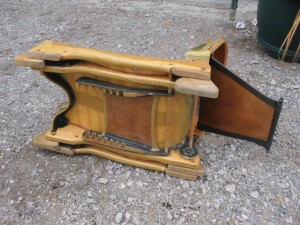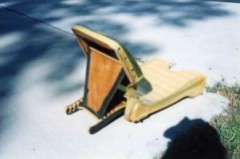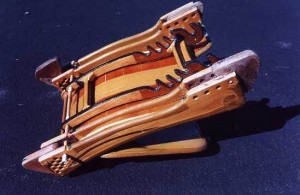Seats/Seats for Sailing Canoes
Previously published in Small Craft Advisor, January/February 2003, Issue No. 19
'I might as well paddle,' I thought. Within minutes of pushing off the rocks, and prying the heavily loaded sailing canoe into the wind, I said to myself something like, 'Idiot. You blanking moron. You forgot to raise the seat again!!'
Here in Lake Huron's North Channel, two miles straight into the wind is a lee of granite hills holding
Little Detroit Passage. A warming, light air September morning had become a dead beat in rising wind.
Fetch is a couple miles southwest to a scattered reef, a half dozen miles to a small island, then open North
Channel. Meade Gougeon in his sailing canoe Serendipity, and Jan Gougeon in his new Serendipity sister are
nearly out of sight on port tack, maybe already in the lee.
They'd set their full rigs after breakfast, but not me. We'd paddled out a quiet pass to the McBean Channel. I'd stepped ashore, set full sail, and fiddled with gear and luff ties. Meade and Jan between them have eighty years experience cruising and racing, usually winning, on the Great Lakes. I don't know why I didn't set Puffin's sail when they did.
* * *
Now I'm making seats for the six new Serendipity Sisters, so it's a good time to talk seats.
|
|
In my complaint, I meant I hadn't set the seat to a high paddling position twice, when it mattered, which is a crappy average, for the three times this year I paddled Puffin any distance.
 Each corner of the seat's bottom is adjustable two inches up or down, with a one inch step between.
Hopefully, says the optimistic sailor, the seat is often low in the sailing position. But if a tough
paddle's coming, raising the seat helps paddling leverage, and reach over the coaming and sheer.
Each corner of the seat's bottom is adjustable two inches up or down, with a one inch step between.
Hopefully, says the optimistic sailor, the seat is often low in the sailing position. But if a tough
paddle's coming, raising the seat helps paddling leverage, and reach over the coaming and sheer.
Anticipating hard paddling, I sometimes raise the seat full height aft, but forward just mid height. On the beach or in the tent, I use the highest settings, or lower the rear an inch. An experienced single blade paddler mentioned he'd try his seat tilted, sometimes, to one side or the other.
* * *
In June, Howard Rice in Meade's Serendipity, and I in Puffin, had sailed in northern Lake Michigan's Beaver Islands, to Squaw Island from Garden Island. It was a stiff, close reach. We had single reefs in, but I'd feathered most of the way, into an 11-14 knot plus southwesterly.
Before returning to Garden, we'd stood on Squaw's leeward spit. Wind swirled and gusted. I said I'd paddle back, thinking no need to rush. It'd be a nice downwind ride, lovely scenery, and I could avoid a gusty run. So I struck her rig and raised the seat. Howard took off hiking out.
Paddling back to Garden was lying back paddling easy, and sprint strokes and/or wide sweeps. When paddling hard, the back of the seat wants to be more upright --- check the form of flatwater racers using double paddles. On this crossing, other seat adjustments came into play, and one adjustment had been made before the trip.
This leads to how our bodies react to lumbar support when partially reclined versus upright.
Generally, lumbar support wants to be lower as the seatback reclines. On our seats, the position of the
lumbar support adjusts relative to the axis of the back's hinge, which in turn sets the seat bottom
in a fore and aft, and vertical relationship with the lumbar bulge. And the axis adjusts fore and aft,
too. The adjustments give enough range of lumbar position, I think, so the seat can fit anyone, and accommodate
one's choice of padding, if any.
 To change the back angle, Puffin's seat slides fore or aft while the back leans on a thwart.
Meade uses a line support, like popular camp seats. Jan uses a strut and receiver with seven
angle adjustments. It's developed from what I use ashore, inspiration having been an old rattan,
reclining beach seat.
To change the back angle, Puffin's seat slides fore or aft while the back leans on a thwart.
Meade uses a line support, like popular camp seats. Jan uses a strut and receiver with seven
angle adjustments. It's developed from what I use ashore, inspiration having been an old rattan,
reclining beach seat.
Back on Garden Island with Howard, he said his return had been fun and less dicey because he'd been sitting out, compared to the morning's sail when he'd been in the boat. The gusts off the tip of Squaw misled me, and I could've sailed back, too. It had taken over a half hour to Squaw close reaching, and an hour and a quarter coming back. It was relaxing, though, a mostly downwind paddle. The seat was set high, weather was gorgeous, and I had a fine view of Garden resolving in afternoon light.
* * *
The goal for the seat is comfort for an eighteen hour day, whether paddling and/or sailing.
The requirements differ greatly --- part of the design problem of the two propulsion methods with sailing
canoes. Paddling likes a seat centered, high and upright for power. Sailing from in the boat wants a seat
low, so one can sprawl and relax, with the capability to move several inches athwartships, for sailing power.
The seat must float, be strong and durable, and scoff at sand and saltwater. Seats are the most difficult things to design, for me, and I imagine for everyone with (a) backbone who designs one. Ergonomics I borrow from car and modern office seating --- can't beat their design budgets --- but our style is hard shell versus sprung and padded, or pressure point reactive. Loads can be huge, too. Imagine a stumbling heavyweight, plopping down on a seat on uneven rocks.
* * *
In the Beavers the next day, I was paddling late afternoon for High Island into increasing wind.
It was southwest and would get to 20-25 plus. Fetch was scores of miles.
Near 4:P Howard and I'd left an islet barely big enough to fit the boats, sailing with single reef, wind southwest 10-15. It was three and a half miles to High. We struck our rigs within a half hour as it was a dead beat with wind building. Howard, a much stronger paddler than I, and in great shape, paddled away fast. Serendipity wasn't yet fitted with spray decks as is Puffin, and Howard was taking water.
 My seat was down in the sailing position. From sitting too low but paddling hard, muscles just below
my rib cage were getting a sore burn. The rudder lifted out of its gudgeons from the yoke plunging into
four to five foot seas. Screw it, I said, I'll paddle harder. I bitterly cursed my inability to raise the
seat in the conditions then. After 7:P, I turned and ran back to Whiskey Island, as exhausted as I've been,
trunk muscles on fire, rudder still dragging off to port, held by steering rods and uphaul line.
My seat was down in the sailing position. From sitting too low but paddling hard, muscles just below
my rib cage were getting a sore burn. The rudder lifted out of its gudgeons from the yoke plunging into
four to five foot seas. Screw it, I said, I'll paddle harder. I bitterly cursed my inability to raise the
seat in the conditions then. After 7:P, I turned and ran back to Whiskey Island, as exhausted as I've been,
trunk muscles on fire, rudder still dragging off to port, held by steering rods and uphaul line.
* * *
Three months later, paddling toward Little Detroit Passage, I was comparing conditions to the June evening in the Beavers. This time the destination was less than two miles. Instead of building waves on open lake, seas were shrinking closer to the lee. It was near lunch, not past a missed evening meal. Puffin's rudder was secure, and wind was only 15-20 knots. In 45 minutes at a slow, steady pace I heard whistling and clapping from rocks above.
With the boats nestled in a tiny marsh, one brother said, "You must be whipped!"
"Good exercise," I nodded, stepping out of Puffin. I thought, though, 'compared to the Beavers it was a stroll.' Carrying my seat and coffee makings ashore, I vowed to make a simple way of changing seat height underway.
* * *
At the lunch table in the Gougeon boat shed in October, Jan's smiling at snapshots from our trip. He compliments me more than he knows, as Meade has, when he says, "It's the most comfortable sailboat I've ever been in --- by far."
~ Hugh Horton
Here is a link to Axel's seat for his sailing canoes. Try it out. Plans are free.